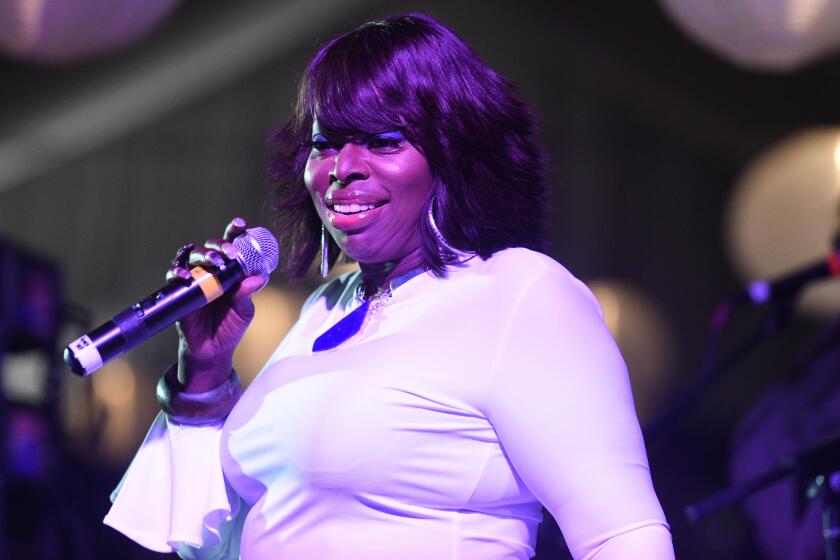‘Calle 54’ Pays Joyous Tribute to Luminaries of Latin Jazz
- Share via
Fernando Trueba, Oscar-winning Spanish director (for “La Belle Epoque”), describes his new film, “Calle 54,” as a “musical banquet” to which he invited his favorite Latin jazz musicians to perform at a Sony recording studio on Manhattan’s 54th Street. For some, the distance from their homes was a matter of blocks, but others came from as far away as Stockholm, Havana, and Cadiz, Spain, as well as Miami. Trueba in turn filmed all of them in their own cities. His tribute to these musicians and their music adds up to a joyous occasion.
Trueba explains he got hooked on Latin jazz when a friend gave him an album back in the ‘80s, and he has drawn upon his considerable skill as a director to present a dozen major artists and their bands in an inviting, gracefully cinematic fashion.
In almost every instance we are introduced to the musicians on their home ground; later in the studio, Trueba and his cameraman, Jose Luis Lopez-Linares, film them and their bands with maximum flexibility, with an eye to simplicity and superb lighting and recording. As a result, “Calle 54” is visually as pleasing as it sounds.
You don’t have to be a certified aficionado or expert to enjoy “Calle 54” thoroughly, and you come away with more appreciation of how inclusive Latin jazz, with its roots in Africa, really is. One of the highlights of the film is having the late Tito Puente, “the godfather of Latino music,” showing off the large mural that covers an entire wall of his City Island restaurant. The ebullient, silver-haired maestro, who died June 1 at 77, points out Dizzy Gillespie--his love of Afro-Cuban music was well-known--Cal Tjader and Miles Davis alongside such Latin jazz greats as Machito and Israel “Cachao” Lopez, the latter performing in the film, as does Puente.
Cachao--”still the king of the bass,” says Puente--performs in a remarkable reunion with pianist Bebo Valdes, who fled Cuba in 1960 for Sweden. The two old friends join forces for “Lagrimas Negras” (Black Tears), and then Valdes, once the orchestra leader of Havana’s famed Tropicana nightclub, performs “La Comparsa” at twin Steinways with his son Chucho, a Havana celebrity in his own right; father and son had not seen each other in five years. (Earlier, Chucho plays solo the haunting “Caridad Amaro.”)
Seated in a Central Park horse-drawn carriage, tenor saxophonist Gato Barbieri, a stocky man of considerable mystique who turned his back on recording from 1982 to 1996, speaks of a time when for him film and music were close: “Godard, Pasolini, Glauber--’Antonio des Mortes,’ ” he mutters emotionally. “It is not possible to live without Rossellini.” The Argentine-born Barbieri composed the scores for Bertolucci’s “Before the Revolution” and “Last Tango in Paris.”
Described by Trueba as “the architect of Latin jazz worldwide,” the Cuban-Irish Chico O’Farrill, who came to New York in 1948, emerges from a Manhattan building a frail old man who walks slowly; at the studio, conducting a big band of the size he has always advocated, he becomes a dapper bundle of energy, generating a resounding rendition of Afro-Cuban jazz. His sequence is filmed in sepia, evoking the way big bands looked as well as sounded in ‘40s movies.
Each man--and one woman, beautiful Brazilian piano virtuoso Eliane Elias, who plays sambas barefoot--are presented as the distinctive presences they are. “Calle 54” opens with Paquito D’Rivera, heir to Gillespie’s orchestra, getting the film off to an appropriate start with “Panamericana.” Other artists highlighted are Chano Dominguez, Jerry Gonzalez and his Fort Apache Band, dazzling pianist Michel Camilo and, performing together, Orlando “Puntilla” Rios and Carlos “Patato” Valdes.
* MPAA rating: G. Times guidelines: suitable for all ages.
‘Calle 54’
(54th Street)
A Miramax presentation. Director Fernando Trueba. Producers Cristina Huete and Fabienne Servan Schreiber. Executive producer Laurence Miller. Cinematographer Jose Luis Lopez-Linares. Editor Dominique Hennepin. Running time: 1 hour, 45 minutes.
Exclusively at the Fine Arts, 8556 Wilshire Blvd., Beverly Hills, (310) 652-1330.
More to Read
The biggest entertainment stories
Get our big stories about Hollywood, film, television, music, arts, culture and more right in your inbox as soon as they publish.
You may occasionally receive promotional content from the Los Angeles Times.








